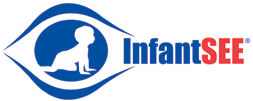EYE EXAMS FOR INFANTS
 In 2005, the InfantSEE® program was developed by the American Optometric Association and The Vision Care Institute of Johnson & Johnson Vision Care Inc. The goal of the program is ensure all infants and their families have access to quality eye care as part of a no-cost public service.
In 2005, the InfantSEE® program was developed by the American Optometric Association and The Vision Care Institute of Johnson & Johnson Vision Care Inc. The goal of the program is ensure all infants and their families have access to quality eye care as part of a no-cost public service.
Bissell Eye Care is a proud member of the InfantSEE® program providing early detection of eye disease. Under this program, participating optometrists provide a comprehensive infant eye assessment between 6 and 12 months of age as a no-cost public service. This public health program is committed to encourage early eye examinations for children 6 months of age or older. Many children do not receive a comprehensive eye examination until they are in their later elementary grades and only get an examination when it is perceived that something is wrong. Most problems occur much earlier and can be prevented with early detection and treatment.
The American Optometric Association recommends having your child’s first eye assessment at six months to check for eye movement, eye tracking and excessive amounts of nearsightedness, farsightedness, or astigmatism.
As baby’s eyes develop in their early months they first begin to focus on objects that are about a foot away. Complex shapes and color contrasts stimulate a baby’s interest. During the first four months, your baby should begin to track movement as they develop hand-eye coordination and depth perception. At six months an eye exam is important to determine any eye conditions that may be present. Although these problems aren’t common, treatment is often most effective when conditions are caught early.
During the eye exam – you will be asked to hold your infant on your lap. The optometrists at Bissell Eye Care will use a variety of things such as puppets and colorful objects in our examination. It’s best to schedule the exam when your child is most alert. During our evaluation, we examine the eye’s structure as well as eyelids, tear ducts, and other parts of the eye.
There are factors that place an infant at risk for eye disease in infants. In reviewing the family history, we look for things such as low birth rate, family history of eye disease, infection of the mother during pregnancy, sexually transmitted disease and difficult or assisted labor.
From eight to twelve months, your baby becomes mobile and is attracted to objects using both eyes to judge distances. Crawling helps to further develop your baby’s hand-eye coordination.
Many eye conditions have no symptoms that can be identified by a parent or in a well visit. Having your child’s eyes checked at an early age provides parents peace of mind in knowing about their child’s eye health.
About the author: John D. Bissell, owner of Bissell Eye Care and Tri-State Low Vision Services, offers comprehensive eye examinations for the entire family, ocular disease detection and treatment, eye glasses, sun glasses, active wear, contact lenses, and low vision examinations for those with significant vision loss. He has undergone specialized training for treatment of low vision by the International Academy of Low Vision Specialists utilizing customized telescopic eyeglasses, prisms and telescopic implants for patients who qualify. The practice accepts most types of vision and health insurance plans.

